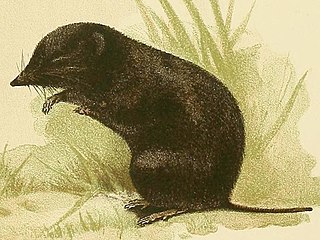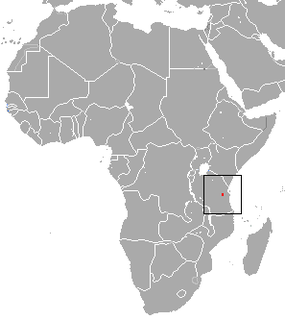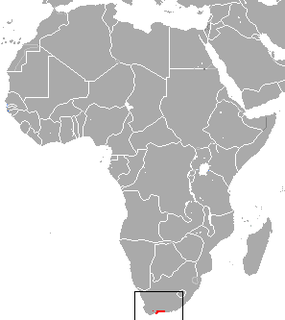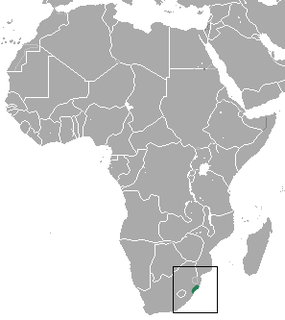
Eisentraut's mouse shrew is a Myosoricinae shrew found only on the island of Bioko, Equatorial Guinea. It is listed as a critically endangered species due to habitat loss and a restricted range.

The Rumpi mouse shrew is a Myosoricinae shrew found only on the Rumpi Hills, Cameroon. It is listed as a critically endangered species due to habitat loss and a restricted range.

The Kahuzi swamp shrew is a species of mammal in the family Soricidae found in the Democratic Republic of the Congo. Its natural habitat is swamp. It is threatened by habitat loss.

The Saharan shrew is a species of mammal in the family Soricidae. It is found in Mauritania and Morocco. Its natural habitats are rocky areas and sandy shores. It is threatened by habitat loss.

Myosorex is a mammal genus in the Soricidae (shrew) family. The genus, collectively referred to as the mouse shrews, contains these species:

The montane mouse shrew is a species of mammal in the family Soricidae endemic to Uganda. Its natural habitats are subtropical or tropical moist montane forests and swamps. It is threatened by habitat loss.

The dark-footed mouse shrew is a species of mammal in the family Soricidae found in Mozambique, South Africa, Eswatini, and Zimbabwe. Its natural habitat is subtropical or tropical moist montane forests. It is threatened by habitat loss. It was formerly sometimes called the dark-footed forest shrew.

The Geata mouse shrew is a species of mammal in the family Soricidae endemic to Tanzania. Its natural habitat is subtropical or tropical moist montane forests.

Kihaule's mouse shrew is a species of mammal in the family Soricidae endemic to Tanzania where it is known only from the Udzungwa Mountains, at the western end of the Eastern Arc Mountains. Its natural habitats are subtropical or tropical moist montane forests and plantations. It is threatened by habitat destruction and the International Union for Conservation of Nature has assessed its conservation status as being "endangered". It was named after Philip M. Kihaule, a medical-entomological technician, who considerably contributed to the documenting of the small mammals of Tanzania and collected the type specimen of this shrew.

The long-tailed forest shrew, or long-tailed mouse shrew, is a species of mammal in the family Soricidae. It is endemic to South Africa, where its natural habitats are Mediterranean-type shrubby vegetation and swamps.

The Oku mouse shrew is a species of mammal in the family Soricidae endemic to Cameroon. Its natural habitat is subtropical or tropical moist montane forests. It is threatened by habitat loss.

Schaller's mouse shrew is a species of mammal in the family Soricidae endemic to the Democratic Republic of Congo. Its natural habitat is subtropical or tropical moist montane forests.

Sclater's mouse shrew is a species of mammal in the family Soricidae endemic to South Africa. Its natural habitats are subtropical or tropical moist lowland forests and swamps. It is threatened by habitat loss.

The thin mouse shrew is a species of mammal in the family Soricidae found in South Africa and possibly Mozambique.

The forest shrew is a species of shrew in the mouse shrew family, Soricidae. It is found in Lesotho, South Africa, and Eswatini. Its natural habitats include temperate forests, dry savanna, Mediterranean-type shrubby vegetation, and temperate grassland. The term "forest shrews" in the plural is sometimes confusingly used to collectively refer to a different genus, Sylvisorex.

The Kilimanjaro mouse shrew is a species of mammal in the family Soricidae endemic to Tanzania. Its natural habitats are subtropical or tropical moist montane forests and swamps.
Pseudosimochromis babaulti is a species of cichlid endemic to Lake Tanganyika preferring areas with rock-rubble substrates. It can reach a length of 11 centimetres (4.3 in) TL. It can also be found in the aquarium trade. The specific name honours the collector of the type, the French explorer, naturalist and conservationist Guy Babault.

According to the current taxonomy, the Myosoricinae are a subfamily of shrews. As such, they form one of three main types of shrews, the other two being the red-toothed shrews and the white-toothed shrews. They are the only one of the three to be found exclusively south of the Sahara Desert, and so they have been described in English as the African shrews, but also many white-toothed shrews are in Africa and therefore this term is more generally used for shrews from Africa in general. The subfamily has three genera and 20 species:
The Bururi forest shrew is a species of mouse shrew native to Burundi. It was first described by Peterhans et al. in 2010, and is defined by a broad hexagonal skull, short tail, and long claws.
















